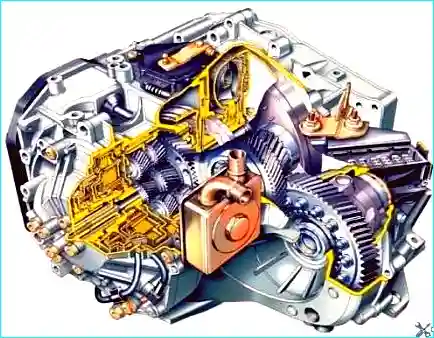The automatic transmission is configured using a traditional planetary design with friction braking and is connected to the engine crankshaft via a torque converter.
The automatic transmission's electronic control system constantly monitors vehicle speed and engine load, eliminating driver error by preventing the driver from upshifting at low speeds to avoid engine overload, or downshifting at excessive speeds to prevent the engine from exceeding the maximum permissible crankshaft speed.
When the vehicle slows, the gears are automatically downshifted without driver intervention.
When the vehicle comes to a complete stop, 1st gear is automatically engaged.
The automatic transmission consists of a torque converter, pump, planetary gear set, multi-plate clutches, multi-plate brakes, and a valve block.
The torque converter functions as a clutch and serves to smoothly connect the engine to the transmission mechanism and increasing torque when the vehicle starts moving.
The torque converter housing is connected to the engine crankshaft via a drive disk and rotates continuously while the engine is running.
The internal cavity of the torque converter is filled with automatic transmission fluid.
The engine rotates the torque converter and drives the pump wheel, which creates a flow of working fluid towards the turbine wheel.
The latter begins to rotate due to the flow of working fluid created by the pump wheel.
When the speed difference between the turbine and pump wheels is large, the reactor changes the direction of the fluid flow, increasing torque.
As the speed difference decreases, it becomes unnecessary and is therefore installed on the overrunning clutch.
The pump, mounted in the front of the gearbox housing, creates pressure and supplies working fluid to all systems in the gearbox.
A planetary gearbox is A gear transmission with external and internal gear engagements, which provides various ways of connecting its elements to achieve different gear ratios.
The operating principle of multi-plate clutches and disc brakes is very similar. The difference is that a multi-plate clutch connects the gearbox links to each other, while a disc brake connects them to the gearbox housing.
The working fluid supplied to the clutch actuates the piston, which compresses the friction discs.
The links locked by the clutch begin to rotate as a single unit.
When the disc brakes are disengaged, the working fluid is no longer supplied to the clutch, and the piston, under the action of a return spring, returns to its original position.
The unique design of a multi-plate clutch is that it is in constant rotation, and the centrifugal force acting on the working fluid creates pressure that prevents it from unlocking. Clutch.
Additionally, a ball valve is installed in the clutch.
It is located as close to the edge as possible from the center of the clutch.
When the pressure of the working fluid in the chamber of the multi-plate clutch increases, the ball valve closes the drain hole. When the pressure in the chamber decreases, the ball valve, under the action of centrifugal force, opens the drain hole and the clutch is released.
The automatic transmission control drive is cable-operated and designed according to the same principle as the control drive of a manual transmission, but differs from it in the number and design of its components.
The automatic transmission selector is installed in the same location on the floor tunnel as the control lever of a manual transmission and is connected to the control unit on the transmission by a cable.
The design of the automatic transmission differential is completely identical to the differential of a manual transmission.
Two sealed holes for the output shafts are made in the differential housing, which allows the transmission to be removed. Without draining the working fluid.
Vehicles with DP0 automatic transmissions are equipped with the "Shift Lock" and "Lock Up" systems.
The "Shift Lock" system prevents the selector lever from moving unless the brake pedal is simultaneously pressed.
When providing roadside assistance in the event of a battery failure, please refer to the vehicle's operating instructions.
The "Lock Up" system, or torque converter lockup, establishes a direct connection between the automatic transmission and the engine.
This is achieved thanks to a "mini-clutch" installed in the torque converter.
The "Lock Up" system is controlled by the automatic transmission ECU.
The automatic transmission is lubricated under pressure, therefore, it is only provided when the engine is running.

Fig. 1. Automatic Transmission Identification Marking
Therefore, to avoid serious damage, it is necessary to follow these rules:
- – Never drive with the ignition off (e.g., on a downhill slope);
- – Do not move the vehicle by pushing it (e.g., to get to a gas station). If such a need arises, take precautions;
Since the vehicle's wheels are driven only when the engine is running, it is impossible to start the engine of a vehicle with an automatic transmission by pushing his





